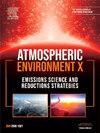氢推进系统对潜在卷云覆盖的区域和季节影响
IF 3.8
Q2 ENVIRONMENTAL SCIENCES
引用次数: 0
摘要
航空运输的去碳化需要新的推进概念,以取代以化石煤油为动力的燃气轮机。在各种方案中,基于 H2 的推进技术是最有前途的候选方案之一,至少在支线和短途航线上是如此。然而,尽管这些飞机有可能将二氧化碳排放量减少到零,但由于使用 H2 作为推进剂时水排放量较高,会增加烟云的形成,因此仍会对气候产生重大影响。为了了解以 H2 为动力的空中交通对气候影响的潜在变化,关键是要评估在代表性大气条件下,烟云形成的可能性和潜在的烟云卷云覆盖率将如何变化。为此,我们开发了一种工具,利用数年的气象再分析数据(ERA-5 和 MERRA-2),结合根据 H2 燃气轮机和 H2 燃料电池推进调整的烟云形成条件,研究其区域和季节变化。计算了三种不同推进设置(煤油燃气轮机、H2 燃气轮机和 H2 燃料电池)下的烟云形成条件,以获得 12 年间潜在烟云覆盖率和潜在烟云卷云覆盖率的全球统计数据。由于水蒸气排放量增加,以 H2 为基础的推进装置更有可能形成烟云。然而,这并不一定转化为与气候相关的形成卷云的可能性。我们以三个区域航空交通热点为重点,发现煤油和 H2 方案之间的差异与季节、高度和纬度有很大的系统性关系。在从典型的无烟云到烟云形成条件的过渡区域,潜在烟云覆盖率约为 50%,潜在烟云卷云覆盖率的差异最大。相比之下,在非常高(接近 100%)或相当低的潜在烟云覆盖率条件下,潜在烟云卷积物覆盖率的差异较小甚至没有差异。这项研究表明,H2 动力空中交通是否会产生更多与气候相关的卷云并不能用一个简单的因素来衡量,而是在很大程度上取决于推进类型、季节、地区和飞行高度。本文章由计算机程序翻译,如有差异,请以英文原文为准。
Regional and seasonal impact of hydrogen propulsion systems on potential contrail cirrus cover
The decarbonization of air transportation requires novel propulsion concepts in order to replace fossil kerosene powered gas turbines. Within various options, H2 based propulsion is one of the most promising candidates, at least for regional and short haul routes. However, despite the potential to reduce CO2 emissions to zero, those aircraft can still have a significant climate impact due to increased contrail formation caused by higher water emission when using H2 as a propellant. In order to understand potential changes in the climate impact of H2 powered air traffic, it is crucial to evaluate how the potential for contrail formation and the potential contrail cirrus cover would change under representative atmospheric conditions. To this end, we developed a tool which uses several years of meteorological reanalysis data (ERA-5 and MERRA-2) in combination with contrail formation conditions adjusted to H2 gas turbine and H2 Fuel Cell propulsion in order to investigate their regional and seasonal variation. Contrail formation conditions for three different propulsion settings (kerosene gas turbine, H2 gas turbine and H2 fuel cell) are calculated to obtain global statistics of potential contrail cover and potential contrail cirrus cover over 12 years. For H2 based propulsion contrails are more likely to form due to the increased water vapor emission. However, this does not necessarily translate into the climatically relevant potential for contrail cirrus formation. Focusing on three hot spots of regional air traffic, we find that the difference between kerosene and H2 scenarios has a strong systematic dependency on season, altitude and latitude. Maximum differences in potential contrail cirrus cover are found in the transition region from typically no-contrail to contrail forming conditions at a potential contrail cover around 50%. In contrast, less to no difference in potential contrail cirrus cover is found at very high (close to 100%) or rather low potential contrail cover. This study demonstrates, that the question whether H2 powered air traffic produces more climate relevant contrail cirrus can not be parameterized by a simple factor but rather strongly depends on the propulsion type, season, region and flight altitude.
求助全文
通过发布文献求助,成功后即可免费获取论文全文。
去求助
来源期刊

Atmospheric Environment: X
Environmental Science-Environmental Science (all)
CiteScore
8.00
自引率
0.00%
发文量
47
审稿时长
12 weeks
 求助内容:
求助内容: 应助结果提醒方式:
应助结果提醒方式:


